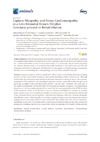Identificador persistente para citar o vincular este elemento:
https://accedacris.ulpgc.es/jspui/handle/10553/70322
| Título: | Capture myopathy and stress cardiomyopathy in a live-stranded risso’s dolphin (Grampus griseus) in rehabilitation | Autores/as: | Câmara, Nakita Sierra Pulpillo, Eva María Fernandez, Antonio Arbelo Hernández, Manuel Antonio Bernaldo De Quirós Miranda, Yara Arregui Gil, Marina Consoli, Francesco Herráez Thomas, Pedro Manuel |
Clasificación UNESCO: | 310907 Patología 3105 Peces y fauna silvestre |
Palabras clave: | Animal Conservation Animal Welfare Biochemistry Cetaceans Histopathology, et al. |
Fecha de publicación: | 2020 | Proyectos: | Patologia Embolica (Gaseosa/Grasa) en Cetaceos (Pegcet-3) Cardiomiopatías de Estrés en Cetáceos |
Publicación seriada: | Animals | Resumen: | Capture myopathy (CM) is described in wild animals as a metabolic syndrome resulting from the extreme stress suffered during and after capture, handling, restraint, and transport. Although CM has been characterized in many species of cetaceans, descriptions of cardiac injury— an important component of this syndrome, and, according to previous authors, comparable to the existing human pathology so-called stress cardiomyopathy (SCMP)—are still rare. Therefore, the main aim of this report is to illustrate, for the first time, the biochemical analysis, and gross, histopathological, histochemical and immunohistochemical features of CM, and more specifically of the SCMP involved in this syndrome, caused by the live-stranding and consequent rehabilitation attempt, for a certain period of time, in a juvenile male Risso’s dolphin (Grampus griseus). The animal presented elevated values of creatine kinase, cardiac troponin I and blood urea nitrogen, with some variations during the rehabilitation period. Histologically, we detected vascular changes and acute degenerative lesions analogous to the ones observed in humans with SCMP. We consider this study to be an important contribution to the study of cetaceans since it could help in decision-making and treatment procedures during live-strandings and improve conservation efforts by reducing the mortality of these animals. | URI: | https://accedacris.ulpgc.es/handle/10553/70322 | ISBN: | 20762615 | ISSN: | 2076-2615 | DOI: | 10.3390/ani10020220 | Fuente: | Animals [ISSN 2076-2615],v. 10 (2), p. 220 |
| Colección: | Artículos |
Citas SCOPUSTM
16
actualizado el 08-jun-2025
Citas de WEB OF SCIENCETM
Citations
14
actualizado el 08-jun-2025
Visitas
116
actualizado el 09-abr-2022
Descargas
33
actualizado el 09-abr-2022
Google ScholarTM
Verifica
Altmetric
Comparte
Exporta metadatos
Los elementos en ULPGC accedaCRIS están protegidos por derechos de autor con todos los derechos reservados, a menos que se indique lo contrario.
